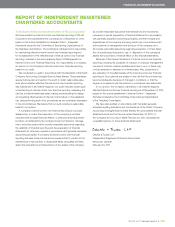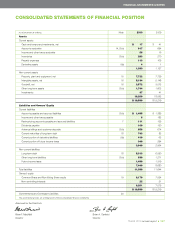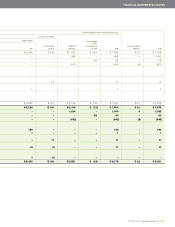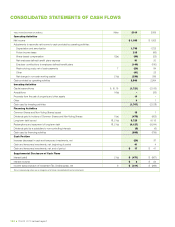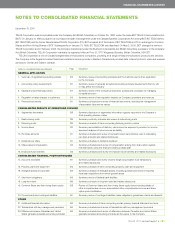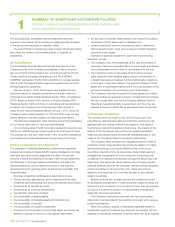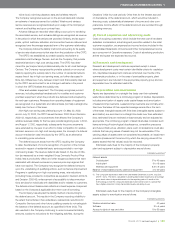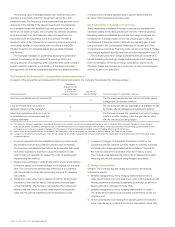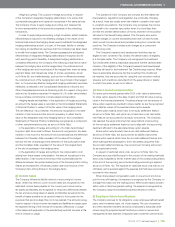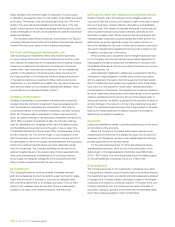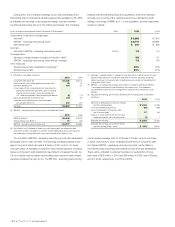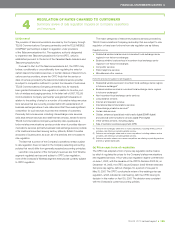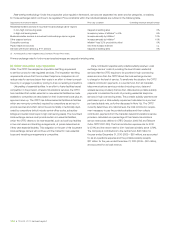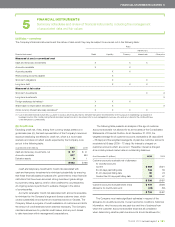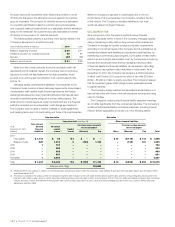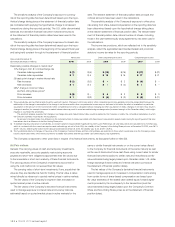Telus 2010 Annual Report Download - page 128
Download and view the complete annual report
Please find page 128 of the 2010 Telus annual report below. You can navigate through the pages in the report by either clicking on the pages listed below, or by using the keyword search tool below to find specific information within the annual report.
124 . TELUS 2010 annual report
of industry and Company-specific facts is used in determining the
fair value of the Company’s reporting units.
(g) Translation of foreign currencies
Trade transactions completed in foreign currencies are translated into
Canadian dollars at the rates prevailing at the time of the transactions.
Monetary assets and liabilities denominated in foreign currencies are
translated into Canadian dollars at the rate of exchange in effect at
the statement of financial position date with any resulting gain or loss
being included in the Consolidated Statements of Income and Other
Comprehensive Income as Financing costs, as set out in Note 8.
Hedge
accounting is applied in specific instances as further discussed in Note 1(i).
The Company has minor foreign subsidiaries that are considered to
be self-sustaining. Accordingly, foreign exchange gains and losses arising
from the translation of the minor foreign subsidiaries’ accounts into
Canadian dollars are reported as a component of other comprehensive
income, as set out in Note 19(b).
The carrying value of intangible assets with indefinite lives, and
goodwill, is periodically tested for impairment using a two-step
impairment test. The frequency of the impairment test generally is the
reciprocal of the stability of the relevant events and circumstances,
but intangible assets with indefinite lives and goodwill must, at a
minimum, be tested annually; the Company has selected December
as its annual test time. No impairment amounts arose from the
December 2010 and December 2009 annual tests. The test is
applied to each of the Company’s two reporting units (the reporting
units being identified in accordance with the criteria in the CICA
Handbook section for intangible assets and goodwill): Wireless
and Wireline.
The Company assesses its goodwill by applying the prescribed
method of comparing the fair value of its reporting units to the
carrying amounts of its reporting units. Consistent with current industry-
specific valuation methods, a combination of the discounted cash
flow approach, the market comparable approach and analytical review
(h) Financial instruments – recognition and measurement
In respect of the recognition and measurement of financial instruments, the Company has adopted the following policies:
Classified as
available-for-sale
or held as part
of a cash flow Classified as
Financial instrument hedging relationship(1) held for trading(1)(2) Company’s reason for classification selection
Short-term marketable security investments(3)
X The Company has selected this method as it better reflects
management’s investment intentions
Long-term investments not subject to X The Company has selected classification as available-for-sale
significant influence of the Company(3) as it better reflects management’s investment intentions
Stand-alone derivatives which are a part of The Company believes that classification as held for hedging
an established and documented cash flow X results in a better matching of the change in the fair value
hedging relationship with the risk exposure being hedged
(1) The distinction between classification as available-for-sale (or held as part of a cash flow hedging relationship) or held for trading is that unrealized changes in the fair values of
financial instruments classified as available-for-sale, or the effective portion of unrealized changes in the fair values of financial instruments held for hedging, are included in other
comprehensive income and unrealized changes in the fair values of financial instruments classified as held for trading are included in net income.
(2) Certain financial instruments that are not required to be classified as held for trading may be classified as held for trading if the Company so chooses.
(3) In respect of investments in securities for which the fair values can be reliably measured, the Company determines the classification on an instrument-by-instrument basis at time
of initial recognition.
.In respect of hedges of anticipated transactions, which in the
Company’s specific instance currently relates to inventory purchase
commitments, hedge gains/losses will be included in the cost of
the inventory and will be expensed when the inventory is sold.
The Company has selected this method as it believes that a better
matching with the risk exposure being hedged is achieved.
(i) Hedge accounting
General: The Company applies hedge accounting to the financial
instruments used to:
.establish designated currency hedging relationships for its U.S.
dollar denominated long-term debt future cash outflows (semi-annual
interest payments and principal payments at maturity), as set out in
Note 5 and further discussed in Note 18(b);
.establish designated currency hedging relationships for certain
U.S. dollar denominated future purchase commitments, as set out
in Note 5; and
.fix the compensation cost arising from specific grants of restricted
stock units, as set out in Note 5 and further discussed in Note 12(c).
.Accounts receivable that are available-for-sale to an arm’s-length
securitization trust are accounted for as loans and receivables.
The Company has selected this method as the benefits that would
have been expected to arise from using the available-for-sale
method were not expected to exceed the costs of selecting and
implementing that method.
.Regular-way purchases or sales (those which require actual delivery
of financial assets or financial liabilities) are recognized on the trade
date. The Company has selected this method as it is consistent
with the mandatory trade-date accounting required for derivative
instruments.
.Transaction costs, other than in respect of held for trading items,
are added to the initial fair value of the acquired financial asset
or financial liability. The Company has selected this method as it
believes that this results in a better matching of the transaction
costs with the periods benefiting from the transaction costs.



